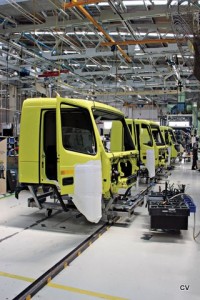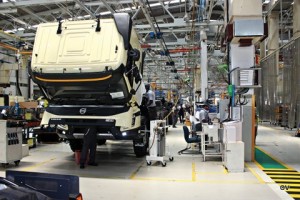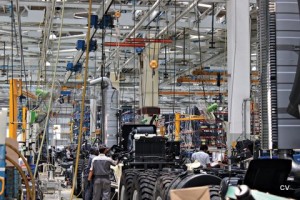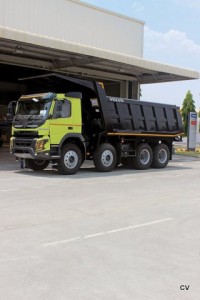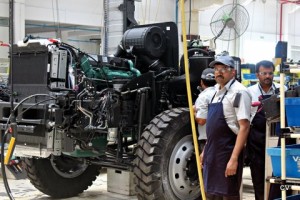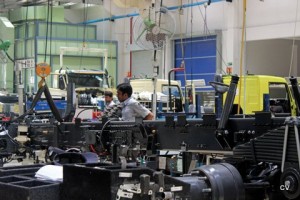After tasting success in the mining segments, Volvo Trucks India is shifting its focus once again to on-road segments.
Story & Photos by:
Ashish Bhatia
The new chief of the Goteborg-based Volvo Group, Martin Lundstedt, has set the ball rolling. The winds of change are upon the Swedish truck major, and the undercurrents of this change are being felt in India. After tasting success in the mining segments with the FMX range of premium heavy-duty deep mining tippers, Volvo Trucks India is shifting focus to on-road segments after what would seem like a long hiatus. It was in 1996, and after deciding to invest in India as the country embarked on an ambitious plan to build infrastructure, that Volvo unveiled the famed FH and FM range of on-road long-haulage trucks under the leadership of Ravi Uppal. It was the beginning of a revolution in the Indian trucking arena. High cost and premium positioning posed a limitation, but the modern trucks rolling out of Hoskote near Bangalore created much scope for aspiration. With the central government, and the minister of road transport and highways, Nitin Gadkari, emphasising time and again on building road infrastructure and no less than 100 kms of new roads everyday, it is quite logical of the Swedish company to shift focus once again to the on-road truck segments. A reason for this could also be the continued replacement demand in the Medium and Heavy (M&HCV) truck segment. The trend in the M&HCV segment is also indicating a preference for trucks that can carry more.
Keen to adopt new metrics to measure success in the Indian context, 95 per cent of Volvo’s sales currently are contributed by the mining trucks. These account for the company’s 60 per cent volume sales in Asia, which is more than what the Swedish company sells in Europe. Having once competed in the on-road trucking space, it may not be difficult for the company to find its way inside. Especially now that it has Eicher to look at as a group entity. Volvo, in comparison to Eicher, is a premium brand. Given its global positioning it will very likely stay that way. It would be therefore interesting to see how Volvo Trucks India finds a way to carve a pie of the heavy-duty truck market, which continues to be price sensitive and TCO oriented. Keen on being assured of profitability, the Indian operator aspires for a Volvo truck for certain, but not without a clear understanding of the difficulties he faces. Volvo, on its part, is counting on its technological prowess. It is counting on its I-Shift Automated Manual Transmission (AMT) to make a difference. Launched in 2015, the I-Shift AMT has come to be a familiar term in Volvo buses. For it to be popular in trucks, there’s work cut out.
Claimed to be shifting away from a region-bound strategy, which was inclusive of a multi-brand approach, Volvo Trucks in India, it is evident, is in for a considerable change. “At Volvo Trucks India, over the next two-to-three years we are looking at a positive growth as far as the Indian market is concerned. Despite mining solutions being our DNA, we want to establish ourselves as a serious transport solutions provider,” expressed Pierre-Jean Verge Salamon, President, Volvo India Pvt Ltd. Salamon stressed upon improving financial performance for the stakeholders. “The foundation for the ambitious strategy (to become the most desired transport solutions provider) will rest on four key pillars, customer success, building of trust amongst all stakeholders, and passion and adaptation to change,” Salamon stated. Salamon added that the Indian truck market is ranked twelfth globally. Claiming to have delivered 208,000 trucks in FY2015, he drew attention to the fact that 98 per cent of his company’s sales came from the FMX mining and construction trucks. Of these, most were delivered by the FMX440 8×4 I-Shift. At Excon 2015, the company unveiled two dump trucks (FM520 and FM480) based on the FMX platform with a 60-tonne capacity, reiterating once again, its emphasis on the mining segment.
That is about to change. Focus is shifting to on-road trucks. Despite attaining product efficiencies, in the case of transportation product portfolio, the company has struggled to reach the apt price points. The offering of I-Shift tech may help as the company finds new in-roads into the on-road trucking segments. The need would be for the I-Shift tech to address the Indian truckers’ often conflicting needs. Averred G V Rao, Vice President – Product Strategy, Brand and Marketing, “The I-Shift on all our offerings (FH, FMX and FM range) by FY2017 will mark the next big leap we wish to achieve.” Found first on the FMX 440 19.5 cu. m. tipper, the I-Shift tech has tasted success in ‘rough’ and ‘hilly’ applications. A 12-speed electronically controlled splitter and range-change automated transmission, I-Shift is laced with an advanced software in the FMX range. It is optimised for mining operations and characterised by a fast gear changing system, featuring minimum interruption in torque delivery during gear change. The technology claimed to have both, high starting traction and high average speed, continuously monitors road gradient, vehicle speed, acceleration, torque, load, rolling and air resistance. According to Rao, it reduces the stress on driveline and tyres, and in-turn translates into lower maintenance and longer service life.
Today no fewer than 80 per cent of Volvo’s FH trucks are equipped with I-Shift, making this AMT (automated mechanical transmission ) virtually a standard feature. When it was launched in 2001 in Europe, there were AMTs on the market already, based on manual gearboxes adapted to permit automatic gear-changing. They were not that reliable. In 2002, one year after I-Shift was launched, 14 per cent of all Volvo trucks sold in Europe were equipped with it. The second generation I-Shift was introduced in 2005. The third generation model came in 2009. What is being offered as of current is the fourth generation model. The penetration of I-Shift, said Rao, grew to 90 per cent by 2015. Keen to find in-roads into the on-road trucking segments, the emphasis on I-Shift could help Volvo Trucks India bring about a change in the way the on-road trucking scene in India is currently like. The financial year 2016-17 will be an important year for the Swedish company. It is the year the truck market is expected to turnaround. The signals of this are visible for the last few quarters. The Medium and Heavy Commercial Vehicle (M&HCV) segment has done double digits. A lot is dependent on infrastructure development. The pace of its development.
Volvo Assembly tech
The truck assembly plant at Hoskote is spread across 122 acres. The layout is such that one line feeds into the other. It is based on the fish-bone concept according to Volvo sources. Producing multiple variants on the same line, the fish-bone concept is claimed to minimise efficiency losses and help find faults quickly. The head of the fish concept is that stage of the assembly where a fully-built truck rolls out. The bones of the fish make the sub-assembly lines that feed the sub-assemblies to the main line. There are two sub-assembly lines that feed to the main line. They contain multiple work stations, which carry out the task of building sub-assemblies. A few other sub-assemblies are a little away from the main assembly. They build crucial parts like the engine, which is fed to the main assembly line. Others execute the task of assembling the gearbox, weld the cab, and mount the superstructure and weld it. There’s also the paint shop. Annually 4000 trucks are made at Hoskote in a single shift operation. The operation can be scaled up to meet a rise in demand.
It takes two days to build a truck. As sub-assemblies feed to the main line, a truck is progressively assembled. A nine stage operation involves the riveting of the chassis members. The next stage involves routing of pneumatic and electrical cables. Brackets for assemblies like fuel tanks and air tanks are fitted at the next stage. At the fourth stage, the axles are mounted. Propeller shaft is also fitted. At stage five, the engine is married to the chassis. The cab is mounted at stage six. Various fluids are added at stage seven. Stage eight involves programming. Every chassis is claimed to have its own unique program, giving each truck an individual identity. The fully-built truck, which incorporates 28 per cent local content, is taken to the test track adjoining the assembly plant for a test run.
Given the volume the Hoskote plant turns out, the operations have been largely mechanised. Anticipating growth from focus on on-road segments, a gradual shift towards automation is likely. Costs will dictate the move. Said Helen Savmyr, Plant Head, Volvo Trucks India, that the aim to increase automation is to match Volvo Truck’s global plants, which are known to operate with minimal human intervention. An interesting bit of the production is a computerised process quality check where each truck is connected to a remote server in Sweden. The embedded software programs are checked. Various functions like lighting, accelerator, brake, gear shift are checked. A fault, if detected, is rectified. On the test track, trained drivers put the truck through its paces for 40 to 50 km. Before the truck leaves the plant, specially trained employees check it thoroughly. The axles are aligned with the help of laser guided alignment equipment. The Hoskote plant is ISO 9000 and ISO 14000 certified. It employs 140 people.



